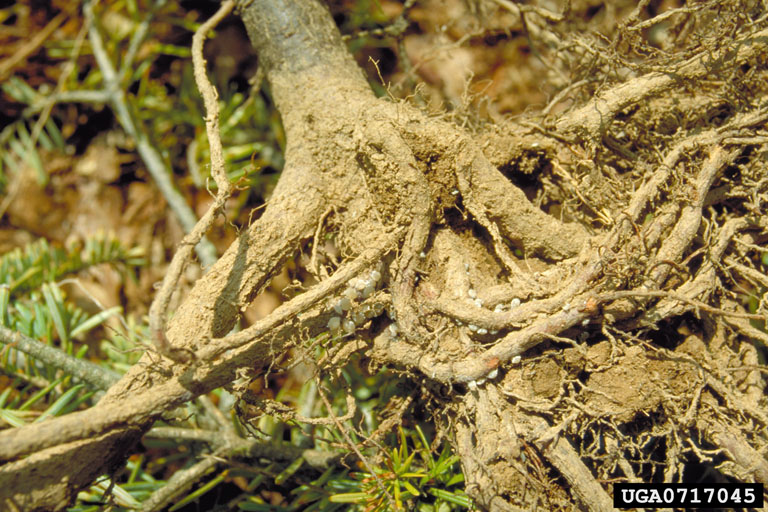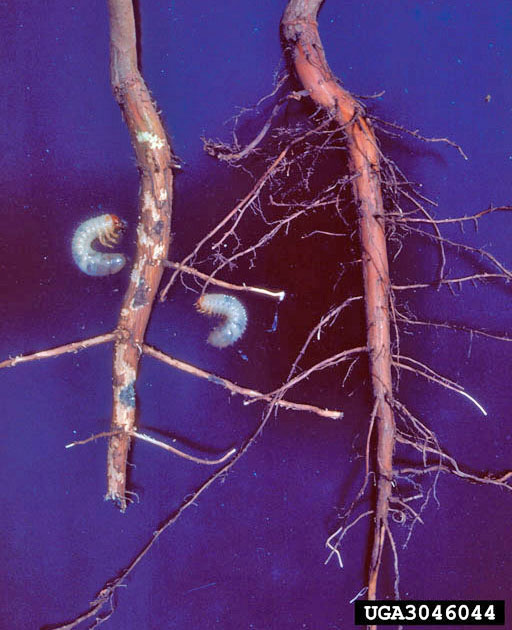Yikes! Yellow trees? What’s going on here?
Soil testing is often the key to diagnosing (and solving) the problem of yellow needles.

Why are my trees turning yellow (Photo 1)? This is a common question we get from Christmas tree growers. Some growers have reported recent tree plantings that do not look well, often indicated by pale-green to yellow needles and poor growth. The cause of these symptoms can be multi-faceted, but should be taken as a warning sign that something detrimental has or is occurring. Simply put, tree needles should be green, not yellow.
What’s going on?
From a physiological perspective, plants have green foliage because of the chlorophyll pigment. Chlorophyll is essential to all plants and functions by capturing light energy which is converted into sugars (stored chemical energy) through the process of photosynthesis. When plants don’t have enough chlorophyll, they begin to turn chlorotic (from their normal green to a lime green or yellow). This will diminish their ability to produce energy, which is needed for future growth and survival.
Why is chlorophyll not being produced?
This is often the crux of the problem and there are many possible reasons as to why this is occurring. Listed below are the most common reasons and recommendations to address each problem. Michigan State University Extension recommends checking through these possible explanations to address the underlying problem to improve tree color, growth and survival.
Incorrect soil pH. Tree species vary in their desired ranges of soil pH (Table 1). Some trees species have a wider acceptable range (Norway spruce), while others are very selective (Fraser fir). When trees are grown outside of their optimal pH range, several tree nutrients, especially manganese and iron, in the soil become inaccessible for tree uptake. Michigan State University (MSU) Extension recommends taking a soil test to determine your soil pH. This is especially important in new production locations or if it has been more than three years since the past soil test. While soil pH levels below optimum can occur, it’s more common to encounter elevated soil pHs (Photo 2). If soil pH is outside the desired range, elemental sulfur can lower the soil pH while lime can increase soil pH to the desired range.
|
Table 1. Recommended soil pH values for conifers used in Christmas tree production. |
|
|---|---|
|
Species |
pH Range |
|
Fraser fir |
5.5 - 6.0 |
|
Concolor fir |
6.0 - 6.5 |
|
Balsam fir/Canaan |
6.0 - 6.5 |
|
Korean fir |
5.5 - 6.0 |
|
Corkbark fir |
6.0 - 6.5 |
|
Nordmann fir |
5.5 - 6.0 |
|
Other fir |
5.5 - 6.0 |
|
Colorado blue spruce |
6.0 - 6.5 |
|
Black hills/white |
6.0 - 6.5 |
|
Scotch pine |
5.5 - 6.0 |
|
White pine |
5.5 - 6.0 |
|
Douglas fir |
6.0 - 6.5 |
Nutrient deficiency. To produce chlorophyll, plants must have sufficient nutrients. Often the most often limiting nutrient is nitrogen, which is a structural component in chlorophyll. Follow the MSU Nutrient Management Guide for nitrogen recommendations based on tree age and species. On very light textured soils, split applications of nitrogen or other practices to improve organic matter may be needed to provide sufficient nitrogen. Ideally, spring fertilizer applications should be done two weeks prior to budbreak.
Tree transplant stress. Trees moved from a nursery setting to the field will undergo some level of stress. Transplant stress is common and may temporarily reduce chlorophyll production. Review the MSU Christmas Tree Planting Guide to minimize this problem. As tree establishment continues, trees often outgrow this stress without further intervention. If trees are still exhibiting chlorotic symptoms several months after transplanting, consider alternative reasons.
Poor root establishment. Conifer root aphids (Photo 3) and white grubs (Photo 4) can feed on tree roots. This is especially damaging to young trees that do not have a well-developed root system. If roots are damaged, trees will be unable to take in adequate nutrients and water. This may result in a nutrient deficiency, leading to yellow needles. Consider pulling up a few trees that look poor and examine roots carefully for signs of feeding damage. Also, consider removing a few healthy tree transplants for comparison. If conifer root aphids or white grubs are found, review the Michigan Christmas Tree Pest Management Guide for control options.


Trees that have chlorotic (yellow) needles should act as a warning sign that something unfavorable has happened. It is not necessarily a death sentence, but steps to address the issue starting with a soil test should be taken as soon as possible.



 Print
Print Email
Email




